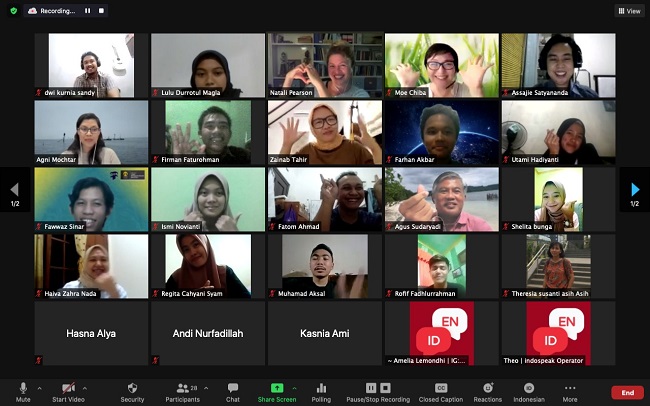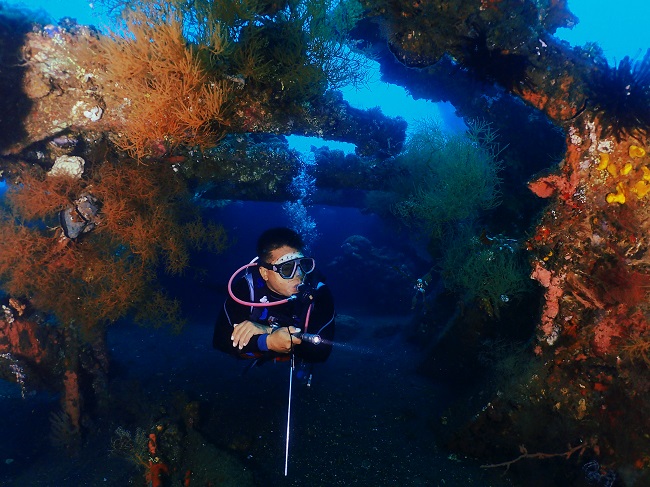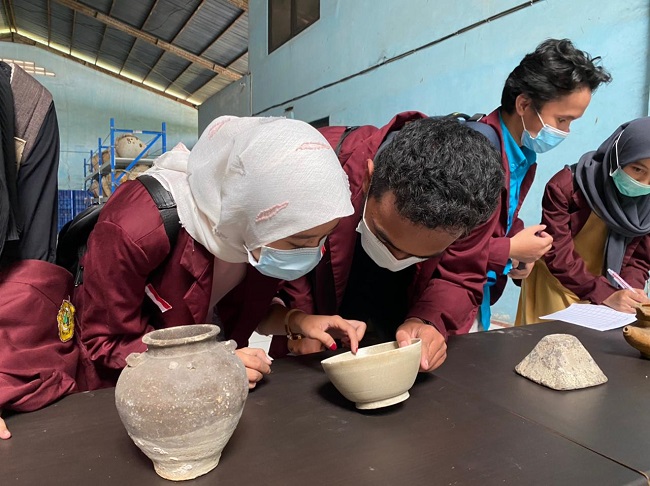Australia-Indonesia maritime cooperation goes digital
Natali Pearson & Zainab Tahir
In early 2021, the Sydney Southeast Asia Centre (SSEAC) at the University of Sydney partnered with the Australian National Maritime Museum (ANMM) and the Ministry of Marine Affairs and Fisheries (KKP) to design and deliver an online short course for maritime heritage and history undergraduates in Indonesia. The course, ‘Collaborative approaches to capacity building in maritime archaeology and underwater cultural heritage’, was supported by the Australian Government through the Australia- Indonesia Institute (AII) of the Department of Foreign Affairs and Trade (DFAT).
The genesis for the course came from our involvement in a DFAT-funded Maritime Capacity Building Initiative (MCBI) project focused on HMAS Perth (I), an Australian shipwreck in Banten Bay off the northwest coast of Java. Whereas the MCBI project focused on government stakeholders and local communities, we wanted to engage more closely with the next generation of maritime archaeologists and heritage practitioners in Indonesia by working directly with students.
Not only did the course allow us to strengthen maritime heritage cooperation – a priority for both countries – but the online format enabled us to overcome, to a degree, the travel restrictions imposed by COVID-19. In doing so, we were able to consolidate our own nascent collaborative partnership while also investing in new relationships with students and institutions across the archipelago.
Participants and recruitment
Fostering an intimate atmosphere in an online environment is difficult. For this reason, we limited course numbers to 16 students. Eligibility was restricted to currently enrolled archaeology and history undergraduate students from four universities: UNTIRTA in Banten, UI in Jakarta, UGM in Yogyakarta and UNHAS in Makassar. To avoid clashing with the students’ university classes, we scheduled sessions on Saturday afternoons in a two-hour window that did not cross over with Muslim prayer times.
We advertised in English and Indonesian through SSEAC channels and our academic contacts at each university. We included a lot of detail to ensure students were aware of the level of commitment required. This included a timetable as well as information about the small group research project that constituted a key component of the course. To apply, students needed to provide academic and personal references, a statement as to why they wanted to participate, and an outline of preliminary ideas for the research project.
As our language of instruction was Indonesian, there was no barrier to participation for students who did not speak English. Our recruitment materials specifically invited students with caring responsibilities to apply, and we also paid attention to gender and other considerations in assessing the applications. Six places were allocated to UNTIRTA students, in recognition of the University’s proximity to Banten Bay and the wreck of HMAS Perth (I). The remaining places were allocated to students from UI, UGM and UNHAS, with one position made available to a student from Universitas Jambi.
Course structure
The course was launched by His Excellency Heru Subolo, Consul General of the Republic of Indonesia in Sydney, and ANMM Director Kevin Sumption AO and ran over six sessions. We engaged the services of an online simultaneous translation company to ensure that English speaking guests could participate without impediment. They also managed all the technicalities associated with Zoom.

The first hour of each session was focused on content delivery in the form of lectures, panels and discussions featuring guest presenters from Indonesia and Australia. Students were introduced to basic themes and principles of maritime archaeology by Stirling Smith, President of the Australasian Institute for Maritime Archaeology. Moe Chiba from the UNESCO Jakarta office spoke to students about the international regulatory context, including the 2001 UNESCO Convention on the protection of the underwater cultural heritage (to which Indonesia is not a signatory).
A panel of five Indonesian archaeologists spoke about the challenges and opportunities of managing and interpreting underwater cultural heritage in Indonesia. Another session was dedicated to the case study of HMAS Perth (I), in which speakers from Indonesia and Australia discussed their efforts to survey the wreck and establish a Maritime Conservation Zone – Indonesia’s first – around the site. Finally, an all-female panel led a discussion on mentoring and career opportunities in maritime archaeology and heritage.
The second hour of each session took the form of a tutorial focusing on the student research projects.
Drawing on the model for SSEAC’s flagship interdisciplinary mobility programs, students were assigned to small groups consisting of participants from at least three different universities. We used tutorial time to support students design and conduct their own mini research project. This included thinking about broad themes relating to maritime heritage in Indonesia, identifying areas of shared interest within the group, designing a feasible research question, considering different methodological approaches, and designing a plan to collect and analyse data. Strategic use of the Zoom breakout room feature was useful in establishing camaraderie within the groups. At the end of week five, students were sent into the virtual field to conduct their research. This pause in online classes coincided with Ramadan, meaning students could manage their time commitments within their groups without the imposition of a regular class. We maintained regular contact with students during this time via WhatsApp.
In the final session, students presented their research projects. Each group was allocated 20 minutes, and each student was required to speak. Guest speakers were invited back to watch these presentations and to contribute to the question and answer session. Research topics included a proposal to develop a temporary exhibition on HMAS Perth (I) at UNTIRTA as a form of both ‘edutainment’ and heritage diplomacy; public involvement in efforts to protect and preserve underwater cultural heritage at the Karang Kijang site in Bangka Belitung province; a plan for a heritage trail based on the historic copra trade in Selayar Islands, South Sulawesi; and an analysis of the role of museums in raising awareness about maritime heritage in Banten province. Feedback provided by one of the guest speakers was that the presentations were remarkable for their depth, substance and clarity.
Site visits
Despite being an online course, we were fortunate to be supported by AII to run some site visits. These were possible due to pre-existing relationships between the course organisers and in-country museum and heritage experts, who were able to act as site visit facilitators. While the rolling lockdowns in Jakarta meant that not all students were able to participate, those that were able to go into the field benefited greatly from the experience.

Students from UNTIRTA visited a shipwreck artefact warehouse in Cileungsi. For many of these history major students, this was their first opportunity to handle archaeological objects. Other students visited Yogyakarta’s Museum Benteng Vredeburg, where they were treated to a guided tour by a curator and conservator of the underwater cultural heritage display. In Makassar, students visited Benteng Somba Opu, a sixteenth century Gowan fort where they searched for a centuries-old chenier line.
Lessons for the future
This short course provided a valuable opportunity to support and extend maritime heritage engagement between Australia and Indonesia, and to do so by engaging with undergraduate students. We wanted to introduce them to new content through guest speakers that brought together international perspectives and Australian expertise within the Indonesian context. More importantly, we wanted to showcase Indonesian expertise by featuring leading archaeologists, academics and practitioners from across the archipelago. This Indonesia-centred approach was fundamental to our course design because it created space to showcase local talent and skills. Of equal value was the opportunity to connect like-minded students across the archipelago. As one student said, ‘The most valuable thing was the growth of new relationships between universities throughout Indonesia’.
Having Australian and Indonesian co-tutors also supported this objective. We played to our individual strengths in terms of designing the curriculum, administration, student oversight, pastoral care, and providing references and contacts when the students needed help with their research projects. By the course’s conclusion, we knew that we could work together on future projects.
We enjoyed experimenting with online tools to support learning. We used Padlet to develop themes and research questions, and recorded and shared each session on Zoom so that students could revisit course content in their own time. We also created a Facebook group and invited students and guest speakers to join. We used this to share links of interest and have kept it open following the end of the course. Not only would this short course not have been possible without these technologies, they in fact added an element of inclusivity and scalability that may have been difficult to achieve through in- person delivery. Even when international mobility returns, we anticipate that such tools will remain a key component of our teaching and research.
Although this course was a one-off, we are keen to explore how programs like this can inform future research projects. In the short-term, that has meant inviting some of the students to do a podcast on HMAS Perth (I) as part of the MCBI project. Perhaps the most valuable learning has been that collaboration remains possible and that it must involve the next generation if it is to be sustainable.
Zainab Tahir (zainab.tahir@kkp.go.id)is Assistant Coordinator of the Shipwrecks Management Unit at the Ministry of Marine Affairs and Fisheries, Indonesia. Natali Pearson (natali.pearson@sydney.edu.au) is Curriculum Coordinator at the Sydney Southeast Asia Centre, University of Sydney.












